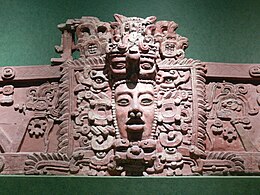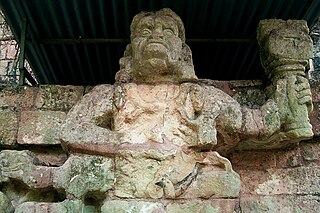
Copán is an archaeological site of the Maya civilization in the Copán Department of western Honduras, not far from the border with Guatemala. It is one of the most important sites of the Mayan civilization, which were not excavated until the 19th century. The ruined citadel and imposing public squares reveal the three main stages of development before the city was abandoned in the early 10th century.
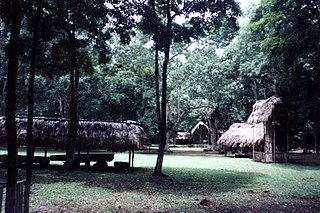
Dos Pilas is a Pre-Columbian site of the Maya civilization located in what is now the department of Petén, Guatemala. It dates to the Late Classic Period, and was founded by an offshoot of the dynasty of the great city of Tikal in AD 629 in order to control trade routes in the Petexbatún region, particularly the Pasión River. In AD 648 Dos Pilas broke away from Tikal and became a vassal state of Calakmul, although the first two kings of Dos Pilas continued to use the same emblem glyph that Tikal did. It was a predator state from the beginning, conquering Itzan, Arroyo de Piedra and Tamarindito. Dos Pilas and a nearby city, Aguateca, eventually became the twin capitals of a single ruling dynasty. The kingdom as a whole has been named as the Petexbatun Kingdom, after Lake Petexbatún, a body of water draining into the Pasión River.

Yaxchilan is an ancient Maya city located on the bank of the Usumacinta River in the state of Chiapas, Mexico. In the Late Classic Period Yaxchilan was one of the most powerful Maya states along the course of the Usumacinta River, with Piedras Negras as its major rival. Architectural styles in subordinate sites in the Usumacinta region demonstrate clear differences that mark a clear boundary between the two kingdoms.
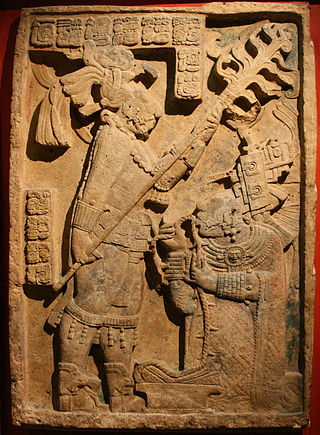
Lady Kʼabʼal Xook or Lady Xoc, was a Maya Queen consort of Yaxchilan. She was the principal wife and aunt of King Itzamnaaj Bahlam III, who ruled the prominent kingdom of Yaxchilan from 681 to 742. She is believed by many to have been the sister of Lady Pacal.

Zapote Bobal is the modern name for a pre-Columbian Maya archaeological site located south of the San Pedro Martir river in the Petén department of Guatemala. The name Zapote Bobal was coined by archaeologist Ian Graham, who discovered the site in the 1970s. It refers to the large number of Zapote Bobo trees, which grow near abundant sources of water in the Petén Basin. The site languished in archaeological obscurity until 2003, when epigrapher David Stuart connected the archaeological site of Zapote Bobal with a name repeatedly mentioned in the inscriptions of sites like Piedras Negras and Yaxchilan. That name was the toponym Hix Witz, or "Jaguar Hill" Scholars had recognized this name for over 20 years, and its connection to a real place prompted the creation of an archaeological project at Zapote Bobal in 2003, the Proyecto Peten Noroccidente (PNO). It is currently directed by James Fitzsimmons and Laura Gamez.
B'alam, Balam, Balaam, B'ahlam, Bahlam, Bahlum or Bolom may refer to:

Maya monarchs, also known as Maya kings and queens, were the centers of power for the Maya civilization. Each Maya city-state was controlled by a dynasty of kings. The position of king was usually inherited by the oldest son.

Yaxun Bʼalam III (also known as 6-Tun-Bird-Jaguar) was a high king of the Mayan city Yaxchilan from 631 until 681.

Lady Eveningstar or Lady Ikʼ Skull (704-751), was a Maya queen and possible regent, wife of Itzamnaaj Bʼalam III, a Maya king of Yaxchilan. Their son, Yaxun Bʼalam IV - "Bird Jaguar", succeeded his father as king. She was possibly a regent between 742 and 751.

Yaxun Bʼahlam IV, also called Bird Jaguar IV, was a Mayan king from Yaxchilan. He ruled from 752 until 768 AD, continuing the period of prosperity started by his father Itzamnaaj Bʼahlam III. He had to struggle to take and hold power, as he was not perceived to be the rightful heir to the throne.

During the 6th and 7th centuries in Mesoamerica, there was an evident shift in the roles women played in ancient Maya society as compared with the previous two centuries. It was during this time that there was a great deal of political complexity seen both in Maya royal houses as well as in the Maya area. Warfare was a significant factor in political competition and marriage was one of the ways that alliances were made between the different polities. This was accompanied by a shift in women's roles from wife and mother to playing integral parts in courtly life, such as participating in rituals involving the supernatural world and at times ruling individual polities.
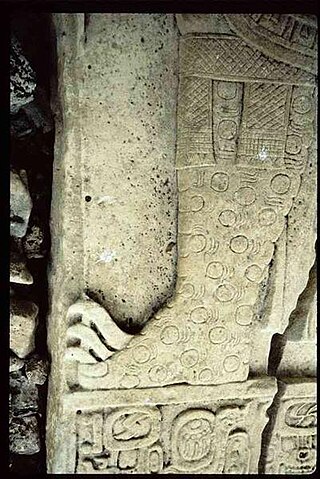
Uchaʼan Kʼin Bʼalam was the fourth Mayan king of Dos Pilas. He is also known as the Ruler 3, Master of Sun Jaguar, Scroll-head God K, Spangle-head and Jewelled-head. His title was "He of Five Captives".
Yoʼnal Ahk III, also known as Ruler 5, was an ajaw of Piedras Negras, an ancient Maya settlement in Guatemala. He ruled during the Late Classic Period, from 758 to 767 AD. Yoʼnal Ahk III ascended to the throne upon the death of Itzam Kʼan Ahk II, who may have been Yoʼnal Ahk's father. He was succeeded by his probable brother, Haʼ Kʼin Xook in around 767 AD. Yoʼnal Ahk III left behind two surviving stelae at Piedras Negras, namely Stelae 14 and 16, the former of which has been called one of the finest niche stelae, according to Simon Martin and Nikolai Grube.

Tuun Kʼabʼ Hix was a Maya king of the Kaan Kingdom.

Lady Pakal was a Maya Queen consort of Yaxchilan in Mexico.

Itzamnaaj Bahlam III was a Mayan king of the city of Yaxchilan which is now located in Chiapas, Mexico. He rose to power in October 681 and continued to rule until his death in June 742. Itzamnaaj Bahlam III is best known for the many buildings and stelae he commissioned during his rule, many of which are still found at Yaxchilan today. He was spouse to Lady Ik' Skull who herself ruled for a time.
Bʼalam Nahn was the seventh ruler of Copan after the reformation initiated by Kʼinich Yax Kʼukʼ Moʼ. His nicknames were Jaguar Mirror and Waterlily-Jaguar. Bʼalam Nehn was the first king to actually record his position in the dynastic succession, declaring that he was seventh in line from Kʼinich Yax Kʼukʼ Moʼ. Stela 15 records that he was already ruling Copán by AD 504. Bʼalam Nehn is the only king of Copán to be mentioned in a hieroglyphic text from outside of the southeastern Maya region. His name appears in a text on Stela 16 from Caracol, a site in Belize. The stela dates to AD 534 but the text is not well understood. Bʼalam Nehn undertook major construction projects in the Acropolis, building over an early palace with a number of important structures.

Tzi-Bʼalam was the tenth ruler of Copan. He was nicknamed Moon Jaguar by archaeologists. He was a son of Bʼalam Nehn, the 7th ruler. He was enthroned in May 553. His surviving monuments were found in the modern village of Copán Ruinas, which was a major complex during the Classic period. The most famous construction dating to his reign is the elaborate Rosalila phase of Temple 16, discovered entombed intact under later phases of the temple during archaeological tunneling work.
Itzamnaaj Bʼalam II was a Mayan king who ruled in Yaxchilan. Experts usually date his reign between the end of the 6th century and the beginning of the 7th century, around 599 or even until around 610. Very little is known of him. He is also called Shield Jaguar by modern writers, based on the name glyph before the phonetic name was deciphered.
